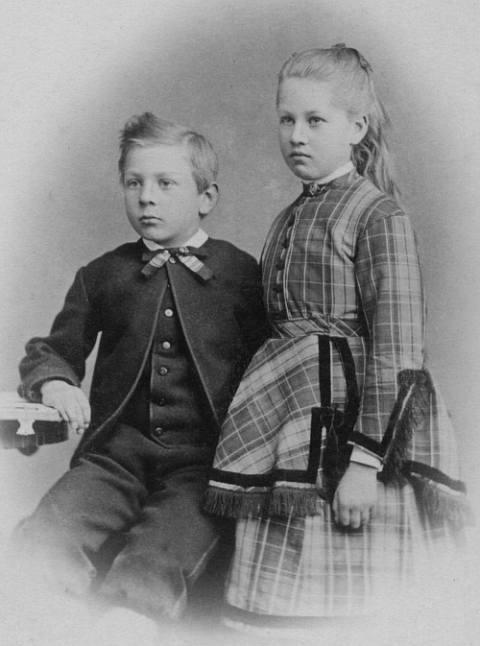
German Cut-Away Jackets: Chronology

Figure 1.-- This brother and sister was photographed in Bremen during 1873. There names were Ina and Ludwig. Unfortunately we do not know their family name. Ludwig wears a very plain jacket without any embroidery or other decoration except edgeing. Ludwig has a matching vest and bloomer knickers. Notice the stripe on the knickers. Image courtesy of the BP collection.
|
|
We see younger German boys wearing suits with cut-away jackets beginning in the mid-19th century. Our understanding of the chronological range is incomplete at this time because of our limited archive of images. This is a difficult style to assess because it appeared at a time when photography was not yet common and we do not have any information on German fashion magazines. And of course the fact that many images are not dates is another complicating factor in building a chronology. We are not precisely sure when this style first appeared and how long the style was popular. We do not yet know if these jackets were worn in the 1840s. We do know that they were worn in the 1850s. The boy here was probably photographed in the late 1860s or 70s (figure 1). We know that the cut-away jacket was very popular for younger boys in the 1860s and 70s. We are not sure about the 1880s. The cut-away jacket was still common in America during the 1880s as it was commonly worn as part of a Fauntleroy suit. As the Fauuntleroy suit was not as commonly worn in Germany, we are not sure how coomon the cut-away jacket was in Germany during the 1880s. As far as we know, the cut-away jacket was not commonly worn in the 1890s.
The 19th Century
1840s
We do not yet know if cut-away jackets were worn in the 1840s. Photography was in its infancy, but there may be some painted portraits. There were Daguerreotypes, but for some reason we have not been able to find very many examples.
1850s
We do know that cut-away jackets were worn in the 1850s. We do not yet, however, have any images to demonstrate this. We do not see American boys wearing cut-away jackets in the 1850s, but our lack of German portraits from the 1850s leaves us rather in the dark here. We suspect that the cut-away jacket appeared in Germany during the late-1850s, but we can not yet confirm this.
1860s
We know that the cut-away jacket was very popular for younger boys in the 1860s and 70s. We note an unidentified boy was probably photographed in the late 1860s or 70s. We note a Poznan boy. The CDV portrait is undated, but looks to have been taken in the 1860s. We note two unidentiied brotherswearing identical cut-away jacket suits in 1864.
1870s
Quite a number of portaits show that the cut-away jacket was still quite common for younger boys. A good example is Ludwig here in 1873 (figure 1). Ludwig wears a very plain jacket without any embroidery or other decoration except edgeing. Notice there are no lapels. Ludwig has a matching vest and bloomer knickers. Notice the stripe on the knickers. We note another unidentified German boy, probably in the 1870s. His cut-away jacket has a very unusual shape. We notice a portrait in 1873 of two Bremen brothers. One wears a cut-away jacket, the other the Hussar-military style.
1880s
We are not sure to what extent the cut-away jacket was worn by German boys during the 1880s. The cut-away jacket was still common in America during the 1880s as it was commonly worn as part of a Fauntleroy suit. As the Fauuntleroy suit was not as commonly worn in Germany, we are not sure how common the cut-away jacket was in Germany during the 1880s. One example of a cut-away jacket we think from the late-1880s is an unidentified Dresden boy, but the date is only an estimate. The cut-away jacket was going out of style in America at his time.
1890s
We still see the cut-away jacket in the 1890s, but we are not sure about the prevalence. They are not quite so onbvious because we not the being done with smll, mostly high-set lapels.
The 20th Century
The cut-away jacket was mostly a 19th century garment, but we still see some in the early-20th century. The jackets we see are not the cut-away jackets of the mid-19th century. These were plain lapel-less jackets like the one the Bremen boy here is wearing (figure 1). The cut-away jackets we see have small, high-set lapels. We see these same high-set lapels with rgular sack suit jackets. We are still assesing how common these cut-way jackets were in the 1900s, but we have found several German examples. They were worn by boys of all ages including younger teenagers. We continue to see boys wearing these ackets with vests. The problem with building these chronologies is that so many of the images are undated. There are, however, some characteristics of cabinet card that help date 1900s portraits.
HBC

Navigate the Boys' Historical Clothing German pages:
[Return to the Main German cut-away jacket page]
[Return to the Main cut-away jacket page]
[German choirs]
[German youth groups]
[German school uniforms]
[German royalty]
[German sailor suits]
[Lederhosen]
[Ethnic]
[Tights]
[Long stockings]
Navigate the Boys' Historical Clothing Website:
[Introduction]
[Activities]
[Biographies]
[Chronology]
[Clothing styles]
[Countries]
[Girls]
[Topics]
[Bibliographies]
[Contributions]
[FAQs]
[Glossaries]
[Images]
[Links]
[Registration]
[Tools]
[Boys' Clothing Home]
Created: 11:34 PM 1/3/2006
Last updated: 8:22 AM 12/14/2017



